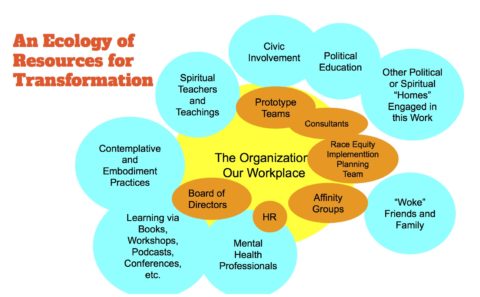An Ecosystem of Resourcing for Racial Equity Culture Change Work
August 5, 2019 Leave a comment
Image by Nicolos Raymond, “Vibrant Hot Air Balloons,” used under conditions of Creative Commons Attribution License 2.0.
Over the past several years we at IISC have had to opportunity to work with colleagues to go deep over a relatively short period of time (2-3 years) with a few organizations facilitating internal culture change for race equity and inclusion. The intensity of this work has offered up opportunity and a number of important lessons, perhaps first and foremost that it is critical to have in place an ecosystem of support and resources to do this work for everyone involved, facilitators included.
IISC President Kelly Bates wrote wisely in a blog post that the work for racial equity is about undoing as much as it is about doing. We do not simply build new culture or behavior on top of old, especially in situations that are characterized by oppression. Some things must be released, and this letting go does not come easy.
There is power and identity and comfort and resources of various kinds invested in the status quo, including in chronic busyness that does not make space for the work or for much of substance to happen. In some cases, there is a preference for existing discomfort that is familiar and that for some is better than uncertainty and instability (the devil you know). But this is exactly what this work calls for – stepping boldly, and together, into the unknown and unknowing and being open to changing who we think we are, how we relate to ourselves and one another.

This can get quite fraught, opening up hard feelings, mistrust, suspicion and trauma. The diagram above from DismantlingRacism.org highlights the “liminal” space in racial equity processes that groups enter when they move beyond the familiar, including “familiar dysfunction,” to unfamiliar dysfunction. This phase is described in the following way:
The stage of “not knowing,” [is] a place where many experience frustration and/or fear. Many if not most people want the process to offer clarity and quick fixes; when the process does not, both POC and white people give into the tendency to identify people and actions as “right” or “wrong.” Some people in the organization move into positions of high righteousness, believing that race equity is based in “one right way” of doing things; energy goes into identifying who or what is “right” and who or what is “wrong.” People can feel very unsettled because this righteous judgment can either lead to significant self-doubt and/or a desire for the organization to address personal ego needs. At the same time, in the middle of this “not knowing,” relationships may begin to subtly shift as some individuals within the organization work to negotiate conflict with heightened personal awareness and increased accountability to the mission. In addition, the organization as a whole begins to recognize ways in which racism is tending to reproduce itself and attempts are being made to address those.
SOURCE: “Racial Equity Stages” from DismantlingRacism.org
Here, while ideally we would hope to be able to lean on one another, it is the reality that other supports are going to be necessary, and beyond what external change facilitators and coaches are able to provide. On the way to achieving more relational trust with and commitment to one another, there are a variety of handrails that can be helpful.
For one of our engagements, my colleague Jen Willsea put together the diagram below to sketch out some of the systemic supports that can be useful for organizations going through race equity change work.

A few notes about what appears in the diagram:
- Contemplative and embodiment practices can be done alone or in groups and include things like meditation, prayer, general somatics, and focusing. This Self-Care Wheel, which I learned about from my colleague and IISC Racial Equity and Training Practice Lead, Aba Taylor, has many great suggestions of practices that can contribute to well-being. Another good resource is the Tree of Contemplative Practices from the Center for Contemplative Mind in Society.
- There are many rich places to find resources for learning. Consider Racial Equity Tools as a place to start. Also consider the Healing Justice podcast and community. The Perception Institute offers cutting edge research on the science of implicit bias, racial anxiety and stereotype and identity threat. In addition, the Food Solutions New England 21 Day Racial Equity Habit Building Challenge website has a lengthy resource list.
- Mental health professionals may or may not have experience around race-based trauma, racial identify formation, internalized superiority and inferiority, etc. It is good to do your homework around this.
- There are growing numbers and revelations of spiritual teachers and teachings that can serve as resources for this work. Some that we have come to appreciate include angel Kyodo williams, Ruth King, Barbara A. Holmes, Howard Thurman, Sherri Mitchell, and Father Richard Rohr.
- Human resource professionals can be key to providing support especially when they are trained in dealing with racism and white supremacy. A helpful resource on this front is this guide from RoadMap.
- The board of directors of an organization is an important lever for change and support, provided it has an unwavering commitment to racial equity, ideally is collectively trained in the history/shared language/key concepts around race and racism, and has people who bring some relevant lived experience and expertise around healing, organizational change and political action.
- There are more and more resources that address the reality of trauma and intergenerational transmission of suffering that results from racism and white supremacy. Consider books such as Trauma Stewardship and My Grandmother’s Hands.
- Some of our favorite conferences include Facing Race, the Equity in the Center Convening, and the White Privilege Conference.
- There are many powerful workshops and on-line trainings out there, including Undoing Racism, PACE trainings from Visions, Inc., unconscious bias trainings, equityXdesign, and our own Fundamentals of Facilitation for Racial Justice Work and Advancing Racial Justice in Organizations (thank you, Cynthia Silva Parker and Nyantara Sen!).
- For more political and historical education, consider books such as Stamped from the Beginning, White Rage, Under the Affluence, An Indigenous People’s History of the United States, Waking Up White, The New Jim Crow, The Fire Next Time, White Fragility, Who We Be; and videos such as Race: The Power of Illusion, Cracking the Codes: The System of Racial Inequity.
- For more on the what, why and how of racial affinity groups and caucuses, check out the resources on this page.
- Thanks to the guidance of Melinda Weekes-Laidlow and inspiration of Christine Ortiz, prototype teams are increasingly a feature of our work with organizations doing race equity and inclusion culture change work. What this looks like is that departmental and other cross-functional teams each create a small testable and scalable experiment at strategic “choice points” to address internalized and institutional racism and white supremacy. When well-facilitated and guided, these are powerful engines of learning and relational trust-building. We are are happy to share more about our experience with these teams, how they operate and what they produce.
- Race equity design, planning and implementation teams are a feature of the work we do around culture change in organizations and networks. These teams are ideally diverse (with respect to race, ethnicity, gender, seniority/tenure, age, function … ), process-savvy and invested in the long-term success of this work. Again, we are happy to share more about these vital teams.
And we certainly welcome additions! What have you found to be helpful, if not crucial, to the work of race equity culture change?